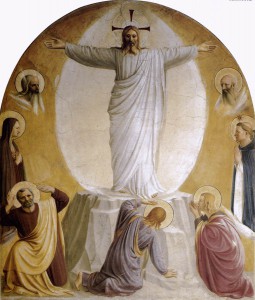 Here is the Collect of the 2nd Sunday of Lent, a new composition for the Novus Ordo based on a precedent in the Liber Mozarabicus Sacramentorum:
Here is the Collect of the 2nd Sunday of Lent, a new composition for the Novus Ordo based on a precedent in the Liber Mozarabicus Sacramentorum:
Deus, qui nobis dilectum Filium tuum audire praecepisti, verbo tuo interius nos pascere digneris, ut, spiritali purificato intuitu, gloriae tuae laetemur aspectu.
Used by early Latin writers such as Sts. Hilary of Poitiers (+c 368), Ambrose (+397) and in liturgical texts, gloria is more than fame or splendor of appearance. Our Latin liturgical gloria is the equivalent of biblical Greek doxa and Hebrew kabod. Romans translated these concepts also with words like maiestas and claritas. Gloria has to do with man’s recognition of God as God. Gloria is a characteristic of God which He will share with us so as to transform us throughout eternity.
The vocabulary of the prayers reinforces that this covenant we are in with God is not a contract between equals: He is Almighty and eternal, we are lowly and mortal.
We do well to beg as supplicants before His Majesty, not as cowed slaves terrified of a harsh master, but with the reverential awe of children looking at authority with the eyes of truth. Our orations during Mass help us to see who we are and who we are not.
LITERAL RENDERING:
O God, who commanded us to listen to Your beloved Son, deign to nourish us interiorly with Your word, so that, once (our) spiritual view has been purified, we may rejoice in the sight of Your glory.
OBSOLETE ICEL (1973):
God our Father, help us to hear your Son. Enlighten us with your word, that we may find the way to your glory.
NEW CORRECTED ICEL (2011):
O God, who have commanded us to listen to your beloved Son, be pleased, we pray, to nourish us inwardly by your word, that, with spiritual sight made pure, we may rejoice to behold your glory.
Note the senses of hearing (audire) and of seeing (intuitus, aspectus), both physically and also inwardly, spiritually.
The voice of God the Father spoke at the Transfiguration commanding us to listen to His beloved Son (Matthew 17:5). We listen to Jesus and look at what He does, both in the pages of Scripture and in His continuing work through Holy Church.
Christ’s words which we hear and His deeds which we see both save us and teach us who we are (cf. GS 22).
Aspectus has both active and passive connotations, that is, the sense of sight, the act of seeing a thing, and the appearance of the thing itself. Aspectus can mean, “mien, countenance”, how something “looks”. Think of Henry V in Shakespeare’s homonymous play inciting his soldiers before battle to “lend the eye a terrible aspect” (III, i).
Intuitus (from intueor) means “a look, a view; respect, consideration.” You know intueor from a verse of the hymn of St Thomas Aquinas Adoro Te Devote: “I am not looking (intueor) at the wounds, like Thomas; I am nevertheless professing faith that you are my God; make me always more to believe in you, have hope in you, love you.” That hymn also sings “ex auditu solo tuto creditur’, only “by hearing” is the doctrine of the Eucharist believed “safely”. Sight, touch and taste can deceive us.
Our intuitus spiritalis could be our own ability to see clearly into the state of our soul. Our intuitus (“insight”, “view”) is that spiritual lens which must be cleansed so that we can have a more perfect “view”. Otherwise, intuitus could be the spiritual landscape within us, the “view” God sees, how we “look” to Him. “View” picks up both views of intuitus (the power to see and that which is seen). “Insight” would favor just one possibility. The cognate “intuition” suggests the wrong connotation from common usage, that is, “sudden insight” or “good guess”.
Both how we see and what is seen in us, our “spiritual view”, must be purified (purificato) so that God is not offended (cf. Habakkuk 1:3)
God and neighbor must see His image in us.
We must see His image in ourselves and others if we are going to treat them with the charity Christ commands.
St. Bonaventure (+1274) wrote about how Thomas the Apostle looked through the Lord’s visible wounds and saw His invisible wound of love.
We must with charity try to look past our neighbor’s imperfections, the wounds caused by sin, to see the intended reality.
Lent is a time for gaining a “view” of the Love who died and rose for us, thus transforming us into more perfect images of who He is: risen, living, glorious.
How are we seen? How do we see? What is our “view”? What is our “look”?
This necessarily requires a close examination of our lives to see and to hear what or whom we have placed at the center of our lives, Jesus Christ’s rightful place.


































that’s timely: i just started spiritual direction yesterday and the corrected translation is a great distillation of what came out of that!
“The intended reality.” Thanks for these valuable comments, Father Z.